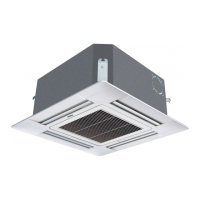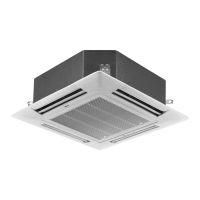105
7.5 Relling the refrigerant
Check the type of refrigerant to be used on the machine nameplate.
Precautions when adding R32
Fill from the liquid pipe in liquid form.(recommend)
1) Before lling, check whether the cylinder has a siphon attached or not.(It should have something like "liquid
lling siphon attached" displayed on it.) (recommend)
2) Be sure to use the R32 tools to ensure pressure and to prevent foreign objects entering.
7.6 Charging with refrigerant
1) This system must use refrigerant R32.
2) Add refrigerant 20g per meter when the total piping length exceeds the standard value, but make sure that the
total liquid piping length should be less than the max. value.
7.7 Precautions for Laying Refrigerant Piping
Cautions on pipe handling
1) Protect the open end of the pipe against dust and moisture.
2) All pipe bends should be as gentle as possible. Use a pipe bender for bending.(Bending radius should be 30 to
40mm or larger.)
Selection of copper and heat insulation materials
When using commercial copper pipes and ttings, observe the following :
1) Insulation material: Polyethylene foam
Heat transfer rate: 0.041 to 0.052W/mK(0.035to 0.045kcal/mhoC)
Refrigerant gas pipe s surface temperature reaches 110oC max.
Choose heat insulation materials that will withstand this temperature.
2) Be sure to insulate both the gas and liquid piping and to provide insulation dimensions as below.
Outdoor unit
Standard total
liauid piping length
Max. total liquid
piping length
3U52S2SG1FA
3U68S2SG1FA
30m 60m
4U70S2SH1FA
4U85S2SH1FA
40m 70m
Gas pipe Gas pipe insulation
O.D.:9.52mm, 12.7mm
Thickness:0.8mm
I.D.:12-15mm, 12.7mm
Thickness:13mm min.
Liquid pipe Liquid pipe insulation
O.D.:6.35mm
Thickness:0.8mm
I.D.:18-10mm
Thickness:10mm min.

